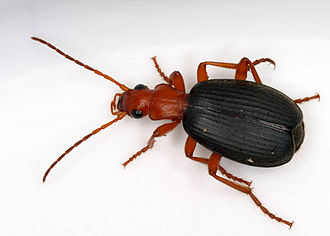Bombardier beetle
Article about the Bombardier beetle
Bombardier Beetle
The Bombardier beetle is a member of the Carabidae family, known for its unique defensive mechanism. These beetles are capable of ejecting a hot chemical spray from their abdomen to deter predators. The spray is produced by a reaction between two chemical compounds stored separately in the beetle's body.
Description
Bombardier beetles are typically small to medium-sized, with a body length ranging from 1 to 2 cm. They have a robust and elongated body, often with a metallic sheen. The coloration can vary, but many species exhibit dark or reddish hues.
Chemical Defense Mechanism
The most remarkable feature of the Bombardier beetle is its ability to produce a hot, noxious spray. This spray is a result of a chemical reaction between hydroquinone and hydrogen peroxide, which are stored in separate reservoirs in the beetle's abdomen. When threatened, the beetle mixes these chemicals in a reaction chamber, where enzymes catalyze the reaction to produce benzoquinone and oxygen. The rapid reaction generates heat, boiling the mixture and creating a high-pressure ejection of the spray.
Species
There are several species of Bombardier beetles, with the most well-known belonging to the genera Brachinus and Pheropsophus.
Brachinus
The genus Brachinus is one of the most studied groups of Bombardier beetles. These beetles are often referred to as "exploding beetles" due to their explosive defensive mechanism. Brachinus species are found in various habitats, including forests and grasslands.
Pheropsophus
Pheropsophus is another genus of Bombardier beetles, known for their distinctive coloration and powerful chemical defense. Pheropsophus verticalis is a notable species within this genus, recognized for its vertical stripes and potent spray.
Ecology and Behavior
Bombardier beetles are primarily nocturnal and are often found under rocks, logs, or leaf litter. They are predatory, feeding on other insects and small arthropods. Their chemical defense not only protects them from predators but also allows them to compete effectively in their ecological niche.
Related Pages
Transform your life with W8MD's budget GLP-1 injections from $125.
W8MD offers a medical weight loss program to lose weight in Philadelphia. Our physician-supervised medical weight loss provides:
- Most insurances accepted or discounted self-pay rates. We will obtain insurance prior authorizations if needed.
- Generic GLP1 weight loss injections from $125 for the starting dose.
- Also offer prescription weight loss medications including Phentermine, Qsymia, Diethylpropion, Contrave etc.
NYC weight loss doctor appointments
Start your NYC weight loss journey today at our NYC medical weight loss and Philadelphia medical weight loss clinics.
- Call 718-946-5500 to lose weight in NYC or for medical weight loss in Philadelphia 215-676-2334.
- Tags:NYC medical weight loss, Philadelphia lose weight Zepbound NYC, Budget GLP1 weight loss injections, Wegovy Philadelphia, Wegovy NYC, Philadelphia medical weight loss, Brookly weight loss and Wegovy NYC
|
WikiMD's Wellness Encyclopedia |
| Let Food Be Thy Medicine Medicine Thy Food - Hippocrates |
Medical Disclaimer: WikiMD is not a substitute for professional medical advice. The information on WikiMD is provided as an information resource only, may be incorrect, outdated or misleading, and is not to be used or relied on for any diagnostic or treatment purposes. Please consult your health care provider before making any healthcare decisions or for guidance about a specific medical condition. WikiMD expressly disclaims responsibility, and shall have no liability, for any damages, loss, injury, or liability whatsoever suffered as a result of your reliance on the information contained in this site. By visiting this site you agree to the foregoing terms and conditions, which may from time to time be changed or supplemented by WikiMD. If you do not agree to the foregoing terms and conditions, you should not enter or use this site. See full disclaimer.
Credits:Most images are courtesy of Wikimedia commons, and templates, categories Wikipedia, licensed under CC BY SA or similar.
Contributors: Prab R. Tumpati, MD



